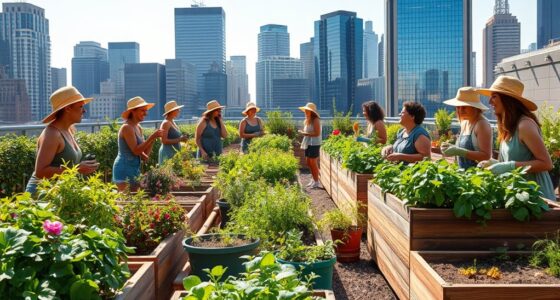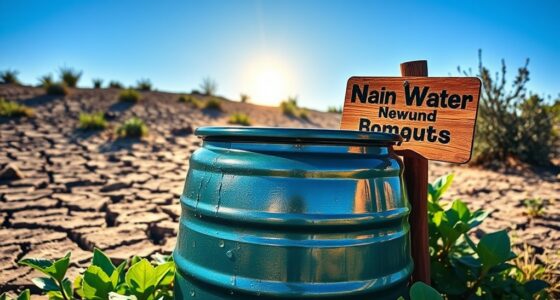To forage safely for edible plants, learn to recognize plants by their leaves, stems, flowers, and growth habits, and pay attention to seasonal changes. Use reliable guides, apps, and local resources to confirm identifications and distinguish safe plants from toxic look-alikes. Practice responsible harvesting and respect local regulations, ensuring plants are mature and abundant. With careful observation and proper techniques, you’ll uncover nutritious wild foods—and if you keep exploring, you’ll master the art even more.
Key Takeaways
- Learn to identify plants using distinctive features like leaves, flowers, stems, and growth habits with trusted guides or apps.
- Recognize look-alike species by examining habitat, seasonality, texture, smell, and environmental cues to ensure safety.
- Use proper tools, community resources, and region-specific guides to verify plant identification and practice responsible foraging.
- Harvest sustainably by taking only mature plants, avoiding overharvesting, and respecting conservation laws and local regulations.
- Properly prepare, clean, and cook foraged plants to eliminate toxins, and keep detailed records for safe, informed foraging practices.
Understanding the Basics of Edible Plant Identification
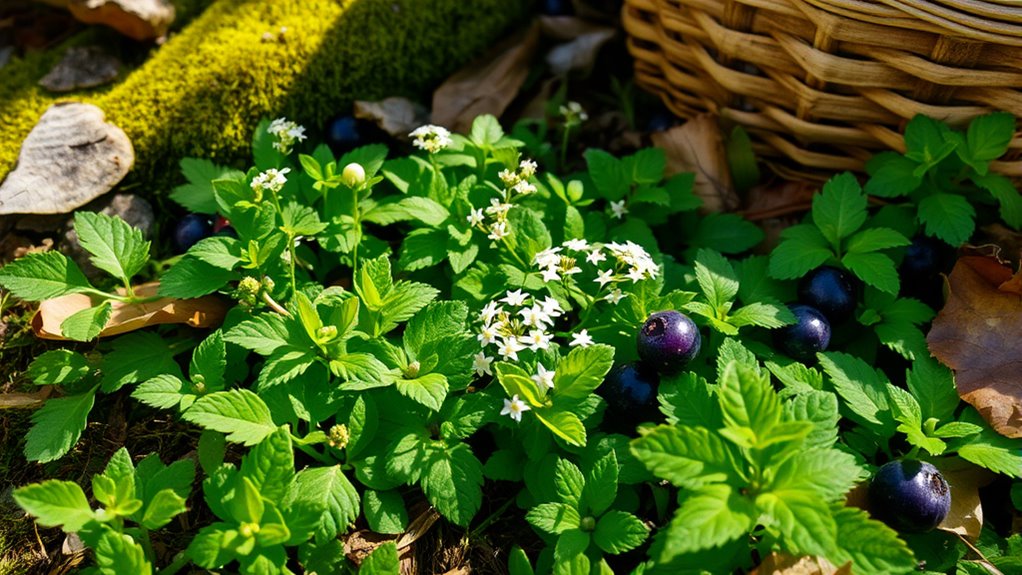
Ever wondered how to tell if a plant is safe to eat? The key lies in plant toxin recognition. First, learn to identify plants by their distinct features—leaves, stems, flowers, and growth patterns. Don’t fall for common edible plant myths; many look similar to toxic species. For example, some berries resemble edible ones but are deadly. Always double-check your identification with reliable sources. Avoid assumptions based on old tales or appearances. Know that even edible-looking plants can have toxic varieties. The safest approach is to master specific identification markers and understand which plants are safe. Remember, misidentification can lead to serious poisoning. Developing a keen eye for detail helps you differentiate between edible plants and dangerous look-alikes, ensuring your foraging is both safe and successful.
Recognizing Common Edible Plants in Your Area
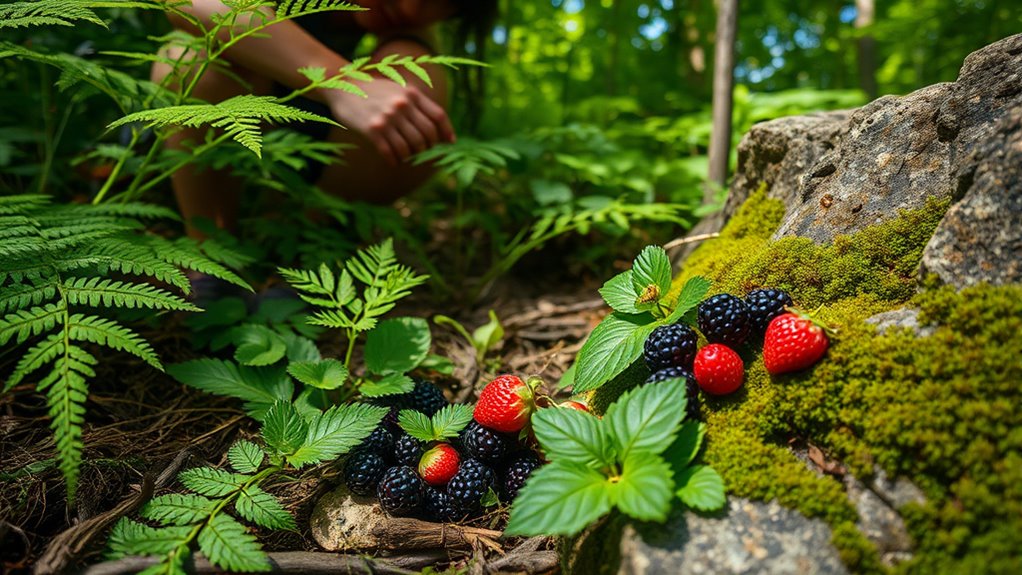
To find edible plants nearby, look for clear indicators like unique leaf shapes or flowering patterns. Keep an eye out for wild plants that stand out from the surrounding vegetation, as they often signal edible options. Using local guides and plant identification tips helps guarantee you’re correctly recognizing safe, nutritious plants in your area. Additionally, understanding foraging range can help you explore different habitats where diverse edible plants may grow, and being aware of seasonal variations ensures you identify plants at their most nutritious and abundant stage. Recognizing plant maturity is also crucial, as it affects both the safety and nutritional value of the plants you collect. Observing air quality indicators can also assist in identifying the healthiest environments for foraging, ensuring the plants you gather are safe to consume. Being familiar with native plant species enhances your ability to distinguish edible options from potentially toxic look-alikes.
Wild Edible Plant Indicators
How can you identify edible plants in the wild? Focus on plant habitat and growth patterns, which reveal valuable clues. Edible plants often thrive in specific environments, like forest edges or meadows. Observe their growth habits: some, like wild greens, grow in clusters, while others, like berries, develop on shrubs. Look for consistent features across similar species in your area. Additionally, understanding cost and budgeting factors can help you plan for safe and sustainable foraging practices. Here are key indicators: 1. Habitat preference—know where your target plants commonly grow. 2. Growth patterns—notice if plants spread in rosettes or vine. 3. Leaf shape and arrangement—distinctive features help distinguish edible from toxic. 4. Seasonal changes—certain plants appear only during specific times, aiding identification. Recognizing edible plant indicators enhances your ability to forage safely and effectively. Moreover, paying attention to plant habitat can significantly improve your success rate in finding safe, nutritious options. Additionally, understanding wild plant growth patterns can help you differentiate between edible species and look-alikes. Recognizing these growth patterns also helps prevent mistaken foraging of toxic plants.
Local Plant Identification Tips
Recognizing common edible plants in your area starts with familiarizing yourself with the local flora and their typical characteristics. When you’re plant foraging, pay attention to leaf shapes, flower colors, and growth patterns that are unique to your region. Use edible plant tips like consulting local guides, field books, or apps to help distinguish safe plants from look-alikes. Practice identifying plants during different seasons, and always double-check before harvesting. Observe the plant’s environment—some edible species thrive in specific soil types or sunlight conditions. Remember, many edible plants have similar features to toxic ones, so take your time and verify identifications carefully. Becoming confident in local plant identification is key to safe and successful foraging.
Differentiating Between Edible and Toxic Look-Alikes
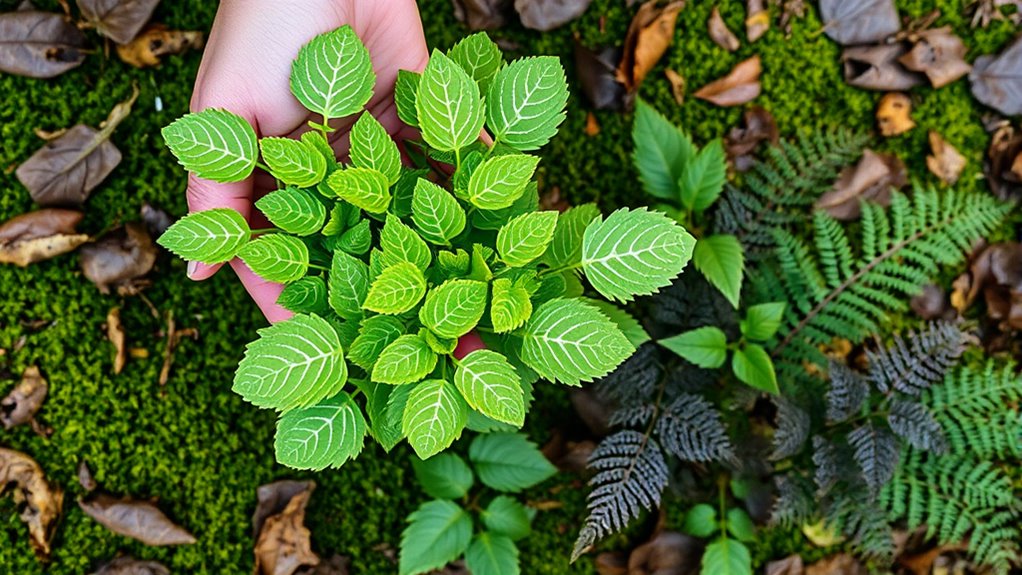
Ever wonder how to tell if a plant is safe to eat or just a dangerous look-alike? Recognizing toxic look-alikes is essential to avoid mushroom poisoning and plant toxicity. Here are key tips:
- Check the leaves: Edible plants often have unique leaf patterns, while toxic look-alikes may have similar shapes but different textures or colors.
- Observe the stem and base: Look for distinctive features like a bulbous base or color changes that signal toxicity.
- Smell the plant: Some toxic plants emit a bitter or chemical odor, unlike their edible counterparts.
- Research specific species: Even small differences can be deadly; always verify with trusted guides before consuming.
Mistaking a toxic plant can be dangerous—always prioritize accurate identification to avoid mushroom poisoning and plant toxicity.
Tools and Resources for Accurate Plant Identification
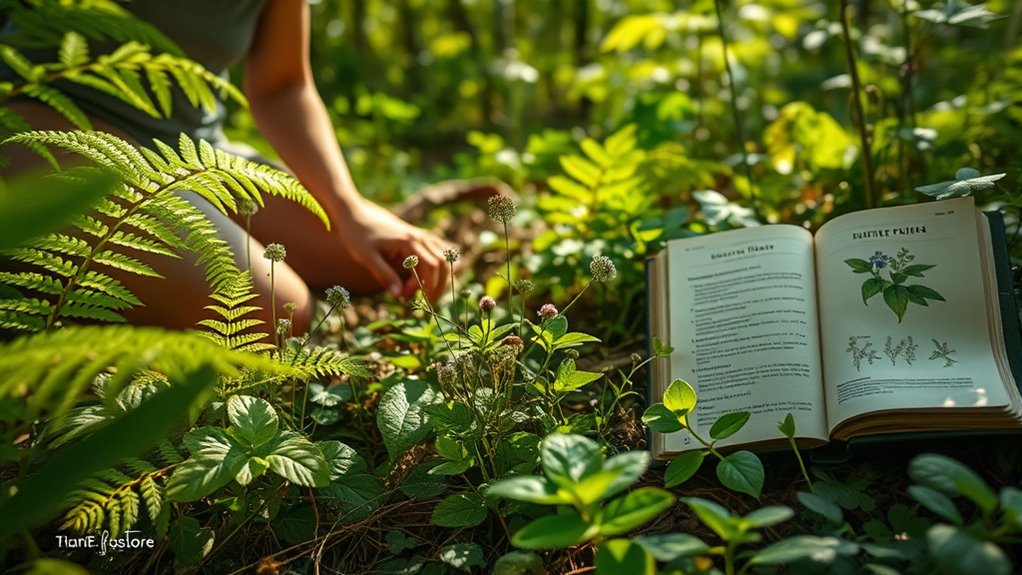
To accurately identify edible plants and avoid dangerous look-alikes, utilizing the right tools and resources can make all the difference. Field guides, plant identification apps, and local foraging groups provide reliable information to guarantee foraging safety. These tools help you distinguish safe plants that offer best plant-based nutrition. Using a guide tailored to your region enhances accuracy, while apps with image recognition can quickly verify plant species. Joining local foraging communities offers practical insights and safety tips.
| Tool/Resource | Benefit |
|---|---|
| Field Guides | Detailed images and descriptions for accurate ID |
| Identification Apps | Quick verification with technology |
| Local Foraging Groups | Community knowledge and safety tips |
Harvesting Techniques to Preserve Plant Safety and Quality
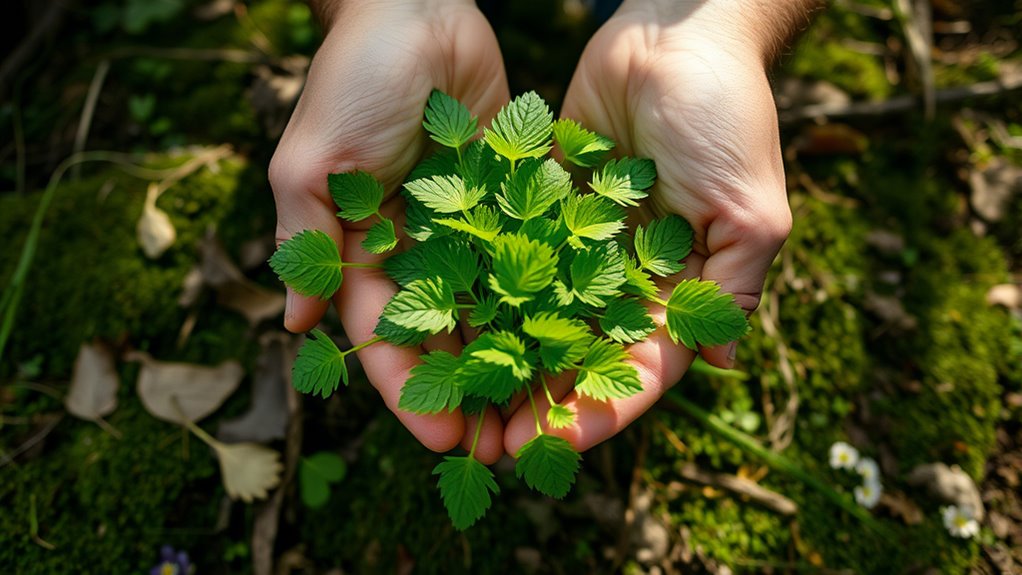
Proper harvesting techniques are essential for maintaining both the safety and quality of edible plants. By following proper methods, you help preserve plant safety and guarantee the plants remain nutritious. Here are four key tips:
- Use clean tools to prevent contamination.
- Harvest only mature, healthy plants, avoiding damaged or diseased parts.
- Cut above a node or set of leaves to promote regrowth.
- Handle plants gently to avoid bruising or contamination.
- Incorporate plant safety practices such as proper storage and handling to further ensure the edibility and freshness of your foraged plants. Additionally, understanding nutritional value helps in selecting the most beneficial parts of the plants to harvest. Regularly monitoring skin health can help prevent adverse reactions from exposure to environmental factors during foraging. Employing climate control techniques can also help preserve the freshness of harvested plants during transport and storage. Maintaining awareness of environmental impact is crucial to avoid damaging ecosystems and ensuring sustainable foraging practices. These harvesting techniques help prevent the spread of disease and maintain the plant’s freshness. Always wash your hands and tools before harvesting, and be mindful of the environment to avoid overharvesting. By applying these practices, you preserve plant safety and ensure your foraged plants remain safe and nutritious to enjoy.
Seasonal Variations in Edible Plant Availability
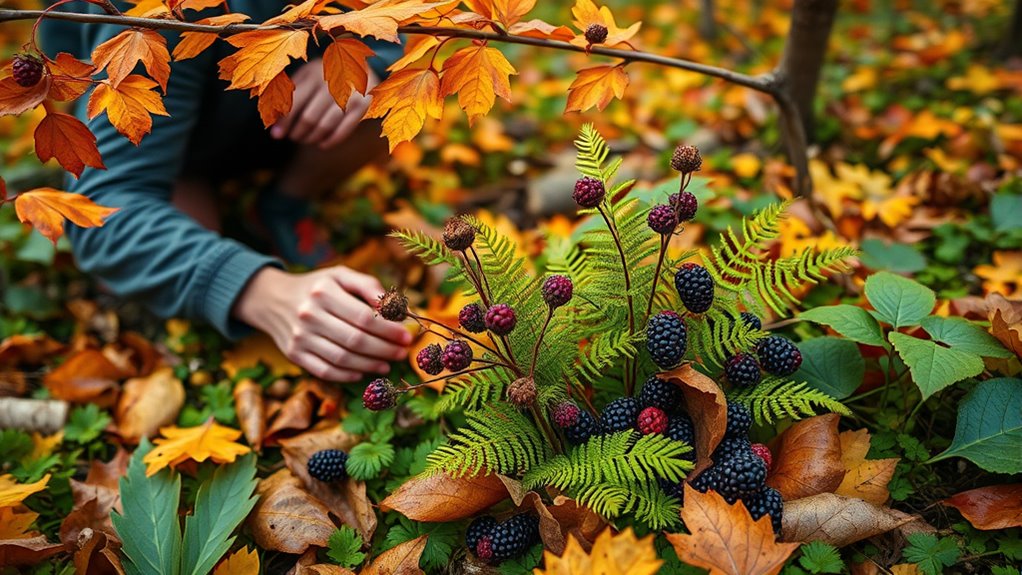
As the seasons change, so does the availability of many edible plants you might forage. Seasonal foraging requires you to adapt your harvesting habits based on plant availability throughout the year. In spring, you can find tender greens, wild herbs, and early blossoms, while summer offers a bounty of berries, flowers, and leafy greens. Fall brings hearty roots, nuts, and late-season berries, and winter may limit plant options but still offers hardy greens and tree bark. Understanding these seasonal variations helps you plan foraging trips more effectively, ensuring you harvest at peak ripeness and avoid overharvesting. Being aware of plant availability during different times of the year also helps you identify which plants are safe and nutritious to target throughout the year. Additionally, catering and delivery services are increasingly catering to health-conscious consumers seeking fresh, seasonal ingredients, highlighting the importance of understanding seasonal foraging for nutritious meal planning. Recognizing the seasonal cycles of plant growth can also improve your foraging success by helping you identify the best times to harvest specific edible plants. Moreover, being familiar with local ecosystems can enhance your ability to sustainably forage without damaging the environment. Furthermore, awareness of storage techniques can help preserve seasonal bounty for year-round enjoyment. To optimize your foraging efforts, understanding the Gold IRA market and its investment strategies can also be beneficial if you’re considering diversifying your assets for long-term security.
Local Regulations and Ethical Foraging Practices

Before you start foraging, it’s important to understand local regulations to avoid legal trouble. Always check if permits are needed and follow any restrictions on collecting certain plants. Respect natural habitats by harvesting responsibly, so the environment stays healthy for future foragers. Additionally, familiarize yourself with copyright and affiliate disclosure to ensure transparency in your activities and avoid unintentional violations. Incorporating ethical foraging practices into your foraging routine can also help you develop innovative ways to identify and utilize edible plants sustainably. Practicing mindful foraging maximizes safety and promotes environmental conservation. Being aware of hydrocolloid technology can also guide you in selecting safe and effective edible plant preparations that support your health.
Legal Considerations
While foraging for wild edible plants can be rewarding, it’s essential to understand the legal regulations that vary by location. You should always check local laws before harvesting. Here are key points to take into account:
- Some areas require foraging permits to collect certain plants.
- Many regions have conservation regulations protecting rare or endangered species.
- Public lands often have specific rules about what can be gathered and how much.
- Collecting without proper authorization can lead to fines or legal trouble.
Respect local laws and always obtain necessary permits. Adhering to conservation regulations ensures you don’t harm fragile ecosystems or deplete plant populations, helping to preserve these resources for future foragers.
Respecting Natural Habitats
Respecting natural habitats is essential to guarantee that your foraging habits don’t harm the environment or deplete local plant populations. Avoid overharvesting by taking only what you need and leaving enough plants to reproduce. Be mindful of pollution effects that can contaminate edible plants and disrupt ecosystems. Stay alert for invasive species, which can outcompete native plants and harm biodiversity. When foraging, stick to designated areas and follow local regulations to prevent damage to sensitive habitats. Ethical foraging also means minimizing disturbance to wildlife and avoiding trampling fragile vegetation. By respecting these principles, you help preserve the health of natural habitats, ensuring that edible plants remain available for future foragers and maintaining ecological balance.
Preparing and Cooking Wild Edibles Safely
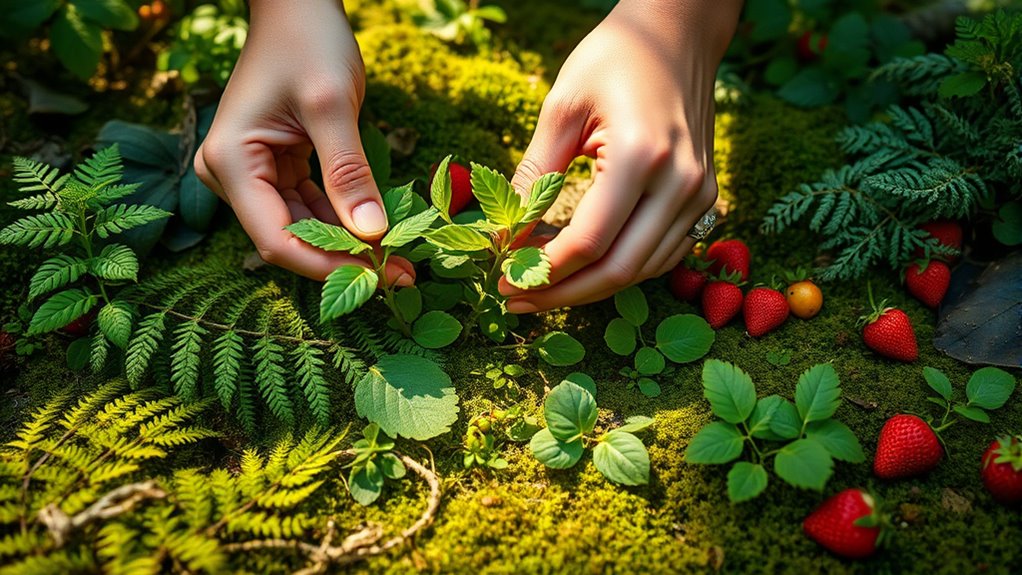
Ensuring wild edibles are prepared and cooked safely is essential to avoid health risks. Proper handling and cooking eliminate toxins and harmful bacteria. To do this effectively, consider these key steps:
- Use appropriate cooking methods, like boiling, sautéing, or steaming, to destroy toxins.
- Always identify plants correctly before cooking; some require special preparation.
- Practice flavor pairing by combining wild edibles with complementary ingredients to enhance taste.
- Rinse thoroughly to remove dirt, bugs, and residues.
Tips for Tracking and Documenting Your Foraging Journeys

Keeping detailed records of your foraging trips helps you remember where and when you found different edible plants, making future foraging safer and more efficient. Use GPS mapping to mark exact locations of fruitful spots, ensuring you can easily return to reliable sources. Maintain a journal keeping detailed notes on plant identification, habitat, and seasonal changes, which helps build your knowledge base over time. Combining GPS data with journal entries allows you to track patterns and preferences, reducing the risk of misidentification. Take photos of plants and their surroundings for visual reference. Regularly update your records after each trip, noting weather conditions and plant abundance. This organized approach enhances your confidence, safety, and success in wild foraging adventures.
Frequently Asked Questions
How Can I Tell if a Plant Is Safe to Eat Raw?
To determine if a plant is safe to eat raw, you should first research plant toxicity and learn its signs. Follow raw consumption guidelines carefully, as some plants may be edible cooked but toxic if eaten raw. Always test a small amount first, and avoid plants with milky sap, strong odors, or unfamiliar features. When in doubt, consult reliable foraging resources or experts to prevent potential poisoning.
Are There Any Plants That Are Edible but Cause Allergies?
Some plants are edible but can cause allergies, known as allergenic plants. You should be aware that allergen identification is essential because certain individuals might react to specific plants like celery, carrots, or nuts. Always test a small amount first and consult reliable resources or experts. If you experience any symptoms, stop eating immediately and seek medical advice. Being cautious helps you enjoy foraging safely without risking allergic reactions.
Which Plants Are Best for Beginner Foragers?
Think of beginner-friendly plants as the welcoming signposts on your foraging journey. Start with easy identification options like dandelions, chickweed, and wild garlic—they’re reliable and safe for newcomers. These plants are abundant, easy to spot, and usually have distinct features. By focusing on these beginner-friendly plants, you build confidence and skills, making your foraging adventures safer and more enjoyable. Just remember to double-check before eating anything unfamiliar.
How Do I Store Wild Edibles Safely After Harvesting?
To store wild edibles safely after harvesting, focus on proper harvest preservation by cleaning them thoroughly. Use appropriate storage containers that are clean, dry, and airtight to prevent spoilage. Keep your wild edibles refrigerated or in a cool, dark place, depending on the type. Label containers clearly with the plant name and harvest date. Proper storage guarantees your foraged finds stay fresh, safe, and ready for use later.
Can I Forage for Edible Plants in Urban Areas?
Yes, you can forage for edible plants in urban areas, but you need to be cautious. Urban foraging requires careful plant identification to avoid toxic species and contamination from pollutants. Stick to well-known, safe plants like dandelions or violets, and always verify your finds with reliable sources. Be mindful of local laws and avoid foraging near busy roads or polluted sites to guarantee your safety.
Conclusion
With curiosity and care, you can confidently forage for flavorful, foraged foods. By blending basic knowledge with keen observation, you’ll improve your edible plant expertise and enjoy nature’s nourishing gifts. Remember to respect regulations, practice ethical foraging, and prioritize safety. So, venture out with vigilance, verify varieties, and savor the sustainable, seasonal bounty waiting just beyond your doorstep. Happy harvesting and healthy harvesting!



